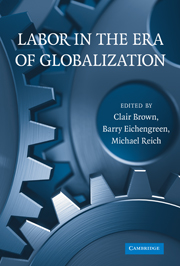Book contents
- Frontmatter
- Contents
- Tables and Figures
- List of Authors and Editors
- Introduction: Labor in the Era of Globalization
- PART ONE POLITICAL ECONOMY AND LABOR MARKET INSTITUTIONS
- PART TWO INSTITUTIONS AND FIRM AND WORKER BEHAVIOR
- PART THREE CONTEMPORARY LABOR–MANAGEMENT RELATIONS
- PART FOUR PUBLIC POLICY AND U.S. LABOR-MARKET STRUCTURE
- Index
- References
Introduction: Labor in the Era of Globalization
Published online by Cambridge University Press: 05 June 2012
- Frontmatter
- Contents
- Tables and Figures
- List of Authors and Editors
- Introduction: Labor in the Era of Globalization
- PART ONE POLITICAL ECONOMY AND LABOR MARKET INSTITUTIONS
- PART TWO INSTITUTIONS AND FIRM AND WORKER BEHAVIOR
- PART THREE CONTEMPORARY LABOR–MANAGEMENT RELATIONS
- PART FOUR PUBLIC POLICY AND U.S. LABOR-MARKET STRUCTURE
- Index
- References
Summary
Seen in the rearview mirror, the third quarter of the twentieth century was a golden age for labor in the United States, Europe, and Japan. Unemployment was low and earnings and employment growth were strong. Employment relations were shaped by an implicit agreement between employers and unions in which workers traded wage moderation for expanding employment opportunities. All was not “sweetness and light,” to be sure. One must guard against idealizing the past and recognize that distance can distort. Recall the warning that graces the rearview mirrors on recent-vintage U.S. cars: “Caution: Objects may be closer than they appear.” Still, it is not too much of a distortion to argue that the majority of workers in the United States, Europe, and Japan were confident that their economic circumstances would improve from year to year.
Sometime in the fourth quarter of the century, this situation began to change. After President Ronald Reagan's firing of striking air traffic controllers, employer resistance to unions took off and the power of labor, already on a downward trend, went into rapid decline. In the United States, wages for male workers stagnated and health and pension benefits for many workers began to erode. In Japan, the winding down of miracle growth in the 1970s and then the onset of a decade-long slump at the beginning of the 1990s challenged the system of lifetime employment. As growth rates slowed in Europe and joblessness rose, labor-market arrangements once lauded for their stability were increasingly disparaged for their rigidity.
- Type
- Chapter
- Information
- Labor in the Era of Globalization , pp. 1 - 12Publisher: Cambridge University PressPrint publication year: 2009
References
- 2
- Cited by



